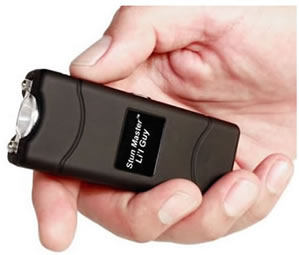Stun Gun vs Taser
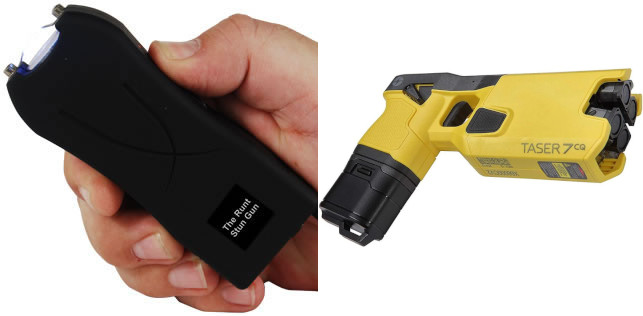
When it comes to non-lethal self-defense weapons, stun guns and TASERs are among the most popular options. However, while many people use the terms interchangeably, these two devices function very differently.
✅ Stun guns require direct contact with an attacker to deliver an electric shock. They are compact, affordable, and easy to carry.
✅ TASER devices fire electrified probes up to 15 feet away, temporarily immobilizing an attacker. They provide distance defense but are more expensive and legally restricted in some areas.
Stun Guns are a Direct Contact Weapon
Lil Guy 60,000,000 volts Stun Gun W/flashlight and Nylon Holster
Which one should you choose? Below, we break down the differences between stun guns and TASERs, their effectiveness, range, costs, and real-world use cases—so you can make an informed decision.
Stun Guns vs. TASERs: Key Differences
Both stun guns and TASERs aim to incapacitate attackers without lethal force, but they do so in very different ways.
Quick Comparison Table:
| Feature | Stun Gun | TASER |
|---|---|---|
| Usage | Direct contact required | Fires electrified probes |
| Range | 0 inches – must touch the attacker | Up to 15 feet |
| Effectiveness | Causes pain & muscle contractions | Neuromuscular incapacitation |
| Cost | $20 - $100 | $400+ |
| Legal Restrictions | Fewer restrictions | Some states require permits |
| Best For | Close-range self-defense | Distance-based protection |
How Do Stun Guns Work?
A stun gun is a direct-contact self-defense weapon that delivers a high-voltage, low-amperage electric shock to an attacker.
How a Stun Gun Works:
1️⃣ Power Source: The device is powered by a rechargeable or disposable battery.
2️⃣ Trigger Activation: When pressed, the stun gun sends electrical energy to metal prongs at the end of the device.
3️⃣ Muscle Disruption: The electricity overwhelms the nervous system, causing muscle spasms, pain, and temporary disorientation.
4️⃣ Escape Opportunity: The attacker is incapacitated long enough for you to escape.
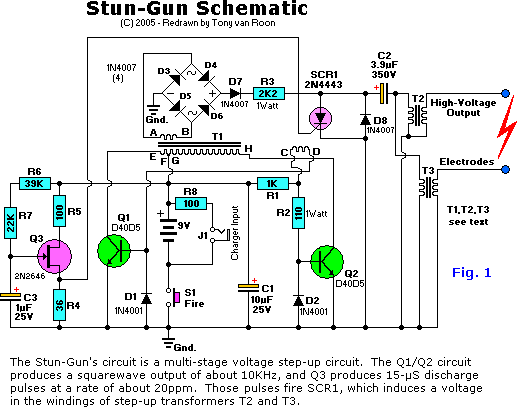
❌ Stun guns do not fire projectiles. They must be pressed directly against the attacker’s body to work.
♦ Best For:
- Close-contact situations
- Compact, discreet self-defense
- Affordable protection
How Do TASERs Work?
A TASER device is a ranged self-defense weapon that fires two electrified darts attached to wires. When the probes make contact, they deliver high-voltage pulses that override the attacker’s muscle control.
How a TASER Works:
1️⃣ Trigger Activation: When fired, the TASER launches two barbed probes at a target.
2️⃣ Wire Connection: The probes remain connected to the device by thin conductive wires.
3️⃣ Neuromuscular Incapacitation: The electrical pulses disrupt the attacker's nervous system, causing full-body paralysis.
4️⃣ Longer Incapacitation: TASERs typically immobilize an attacker for 30 seconds, allowing you to escape.
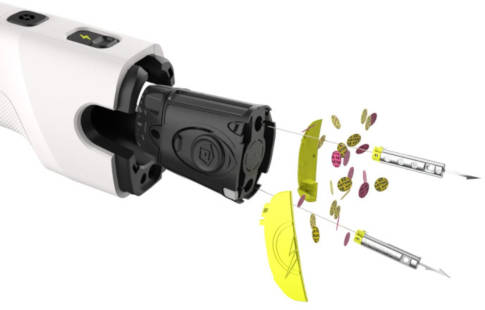
♦ Best For:
- Long-distance self-defense (up to 15 feet)
- Ideal for security professionals
- More effective at fully immobilizing threats
Which One is More Effective?
Both stun guns and TASERs are effective non-lethal weapons, but their effectiveness depends on distance, accuracy, and user training.
Effectiveness of Stun Guns
- Works best when an attacker is within arm’s reach
- Requires direct contact and multiple seconds for full effect
- Pain compliance tool—doesn’t always fully incapacitate an attacker
- Works through clothing but is more effective on exposed skin
Effectiveness of TASERs
- Works best at a distance (up to 15 feet)
- Provides neuromuscular incapacitation, completely immobilizing an attacker
- Probes can penetrate clothing, ensuring high reliability
- Higher success rate in high-stress situations
✦ TASERs are more effective overall, but stun guns are a great backup for close-quarters defense.
Legal Considerations
Not all states allow the purchase and carry of TASERs and stun guns. Some areas require permits, background checks, or restrictions on carrying in public.
♦ Before purchasing, check your state and local laws!
♦ See our guide on stun gun & TASER laws here.
Cost Comparison
One of the biggest factors in choosing a stun gun vs. TASER is cost.
| Feature | Stun Gun | TASER |
|---|---|---|
| Average Price | $20 - $100 | $400+ |
| Replacement Parts | None | Cartridge refills ($30-$60 each) |
| Battery Life | Rechargeable or replaceable batteries | Requires TASER-specific batteries |
| Legal Fees | Minimal (depending on state laws) | Some states require licensing & permits |
✦ If you want a budget-friendly self-defense tool, a stun gun is the way to go.
✦ If you need the best distance-based protection, a TASER is worth the investment.
FAQs: Stun Guns vs. TASERs
Q: Do stun guns work through clothing?
✅ Yes, but they are more effective on exposed skin or through thinner clothing.
Q: Can you be shocked if an attacker is touching you?
✅ No, the electric charge does not transfer to the person holding the stun gun.
Q: What is the best place to stun an attacker?
✅ Aim for large muscle groups (chest, stomach, thighs) for maximum effect.
Q: Are TASERs legal everywhere?
❌ No, some states restrict civilian ownership of TASERs. Always check local laws.
Final Verdict: Should You Get a Stun Gun or TASER?
✦ Get a Stun Gun If:
✔ You want affordable, close-range self-defense
✔ You prefer a discreet, compact device
✔ You need a backup to other self-defense tools
✦ Get a TASER If:
✔ You want distance-based protection (up to 15 feet)
✔ You’re okay with higher costs & legal restrictions
✔ You want maximum stopping power
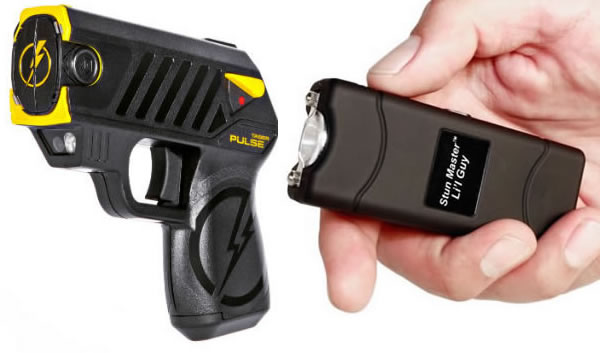
✦ Ready to Buy? Browse our selection of Stun Guns & TASERs today!

